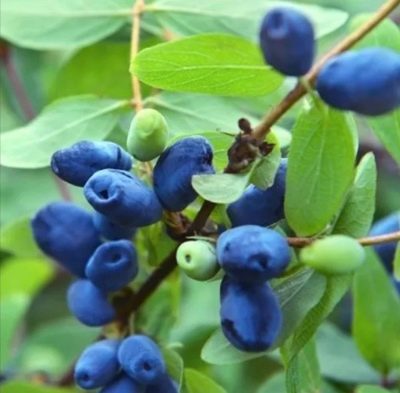
- Authors: Canadian selection
- Name synonyms: Boreal Beauty
- Growth type: vigorous
- Description of the bush: upright, tight
- Bush height, m: 1,2-1,5
- Escapes: strong, tough
- Leaves: green
- Crown: rounded
- Fruit size: large
- Fruit weight, g: up to 3.7
There are many varieties of edible honeysuckle, the fruits of which are not only tasty but also healthy. Boreal Beauty is a Canadian variety that has a late ripening period and has an excellent yield. Berries are rich in useful trace elements and vitamins. The bred variety boasts strong immunity.
Description of the variety
Shrubs are erect and dense. The crown grows round. Growth type - vigorous. Height varies from 1.2 to 1.5 meters, but sometimes taller specimens are found. Shoots grow massive, strong and do not bend under the weight of the berries. This characteristic clearly distinguishes this variety from the background of other varieties. Leaves are green, oval in shape. Boreal Beauty is characterized by active development.
Fruit characteristics
The mass of large berries is up to 3.7 grams. They have a standard elongated shape. Color - purple, with a bluish bloom. The fruit is covered with a dense skin, which helps to preserve the harvest. A fleshy pulp is formed inside. The fruits do not crumble after full ripening and are detached from the stalks with effort.
Taste qualities
Ripe berries have a rich dessert flavor. The sourness is barely noticeable. There is no bitterness.
Ripening and fruiting
Shrubs begin to bloom in May. Due to the late ripening terms, the plant begins to bear fruit in July (sometimes the ripening period falls from the end of July to the first half of August). The crop is harvested every season.
Yield
Experienced gardeners report high yields. On average, it is possible to collect about 6 kilograms of berries from one shrub. The fruit can be picked mechanically thanks to the firm skin.

Self-fertility and the need for pollinators
Boreal Beauty honeysuckle is self-fertile, therefore it needs pollinators. This variety responds remarkably to cross-pollination. When purchasing seedlings, you need to immediately order pollinating plants. On the same site, together with the above variety, it is desirable to plant varieties such as Boreal Blizzard or Boreal Bist. All these species bloom in the same period.
With their help, the berries will be large, and the yield will be regular and abundant. Horticultural crops should be planted in compact groups of 3-5.
Growing and care
The Kamchatka variety is very fond of light, therefore, for its cultivation, you need to select the appropriate site. The shade will be bad for fruiting. And also the area should be flat or slightly sloping. Shrubs are not afraid of cold weather due to their high frost resistance, so there is no need to protect them from frost.
You can plant seedlings in any soil, only swampy or dry sandy soil will not work. The land plot begins to be prepared in the fall. It is cleared of weeds and fertilized with manure. And they also dig out the landing holes in advance, keeping a gap of 1.5-2 meters between them.
It is advisable to plant apple trees near the honeysuckle bushes. These trees have a beneficial effect on their growth and are able to protect them from excessive solar activity.
And also the culture should receive the required amount of moisture, especially on hot summer days. Consumption - 10 liters per shrub. Water them twice a week. The procedure should be performed in the morning or in the evening, as the delicate foliage can get burned during the day. Experienced summer residents recommend periodically spraying honeysuckle with a spray bottle for five minutes.
In the spring, planting is weeded and cleaned of weeds. After completing all the necessary procedures, the land is irrigated.
When caring for young plants, it is imperative that broken and diseased branches are cleaned. From the seventh year of life, annual pruning is performed to help maintain high yields and good plant health. The work is recommended to be carried out in the fall, after the foliage has completely fallen off. With the arrival of spring, the buds bloom early.
The upper part of the crown is not touched, and strong shoots are kept in the amount of 7 pieces. After 15 years, you will need a rejuvenating pruning to the base. In order for new shoots to grow as soon as possible, you need to regularly water and fertilize the shrubs.
As for the introduction of dressings, they begin to be used only from the third year of the life of honeysuckle. During the first two years, the culture feeds on substances that were laid in the planting pits.
For the active growth of green mass, nitrogen fertilizers will be needed. It is not difficult to prepare the nutritional composition yourself. It is enough to dissolve a tablespoon of urea in 10 liters of water. Foliar dressing is performed shortly before the start of flowering.
Store-based formulations such as "Aquarin" and "Master" demonstrate high efficiency. Before adding them, they are dissolved in water at the rate of 20 grams per 10 liters.



































































